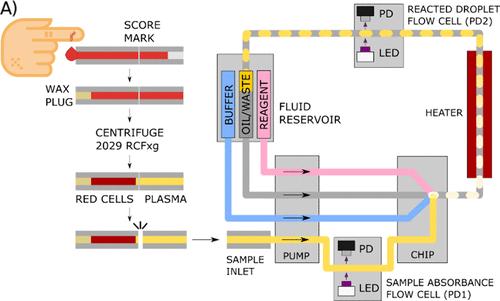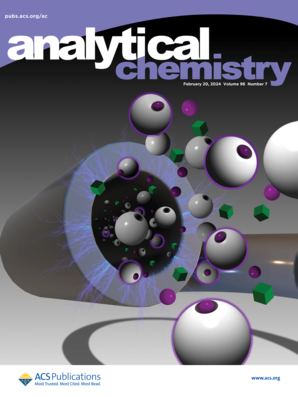A Droplet Microfluidic Sensor for Point-of-Care Measurement of Plasma/Serum Total Free Thiol Concentrations
IF 6.7
1区 化学
Q1 CHEMISTRY, ANALYTICAL
引用次数: 0
Abstract
Total free thiols are an important marker of the whole-body redox state, which has been shown to be associated with clinical outcome in health and disease. Recent investigations have suggested that increased insight may be gained by monitoring alterations of redox state in response to exercise and hypoxia and to monitor redox trajectories in disease settings. However, conducting such studies is challenging due to the requirement for repeated venous blood sampling and intensive lab work. Droplet microfluidic sensors offer an alternative platform for developing a point-of-care testing approach using small sample volumes and automated systems to complement or ultimately replace laboratory testing. Here we developed a small, portable droplet microfluidic sensor that can measure total free thiol concentrations in 20 μL human plasma (or serum) samples, providing a reading in less than 10 min. This system features a novel method to enhance the mixing of reagent and analyte in droplets containing viscous biological fluids. The results in a range of real-world human plasma samples showed equivalence with current standard laboratory assays while reducing sample volume requirements 9-fold and fully automating the process. Micro hematocrit capillaries allowed testing of capillary blood samples collected by fingerprick lancing. The system was used to monitor total free thiols using fingerprick samples in healthy volunteers and revealed significant changes in total free thiols in response to food intake and exercise. This device has the potential to improve our ability to conduct physiological studies of total free thiol level changes and improve our understanding of redox physiology, which may ultimately be applied in redox medicine to improve patient care.

求助全文
约1分钟内获得全文
求助全文
来源期刊

Analytical Chemistry
化学-分析化学
CiteScore
12.10
自引率
12.20%
发文量
1949
审稿时长
1.4 months
期刊介绍:
Analytical Chemistry, a peer-reviewed research journal, focuses on disseminating new and original knowledge across all branches of analytical chemistry. Fundamental articles may explore general principles of chemical measurement science and need not directly address existing or potential analytical methodology. They can be entirely theoretical or report experimental results. Contributions may cover various phases of analytical operations, including sampling, bioanalysis, electrochemistry, mass spectrometry, microscale and nanoscale systems, environmental analysis, separations, spectroscopy, chemical reactions and selectivity, instrumentation, imaging, surface analysis, and data processing. Papers discussing known analytical methods should present a significant, original application of the method, a notable improvement, or results on an important analyte.
 求助内容:
求助内容: 应助结果提醒方式:
应助结果提醒方式:


